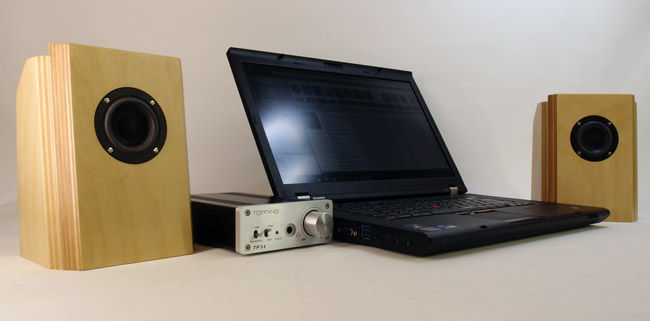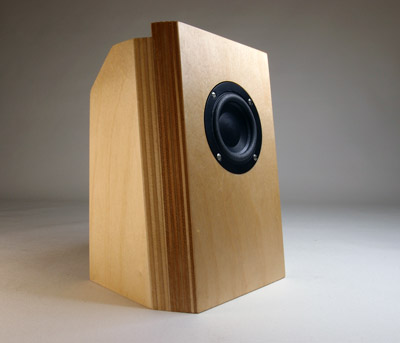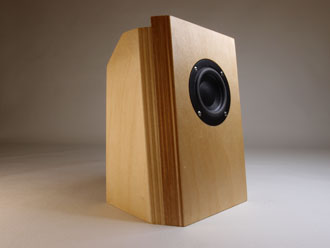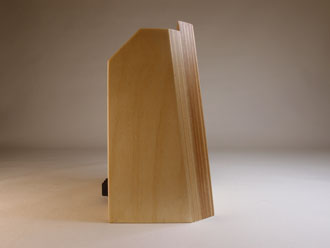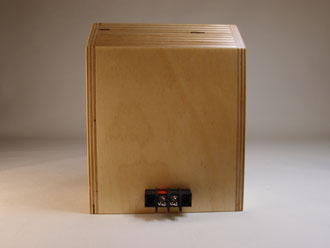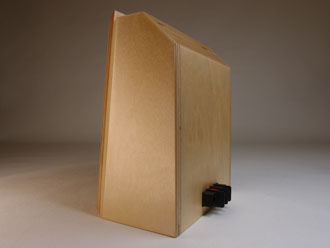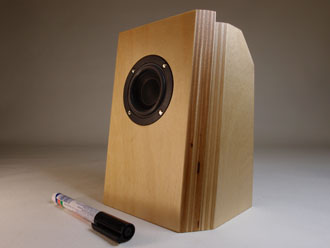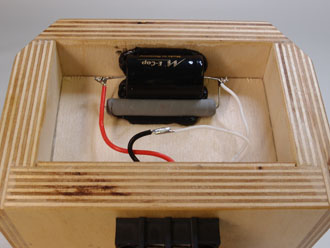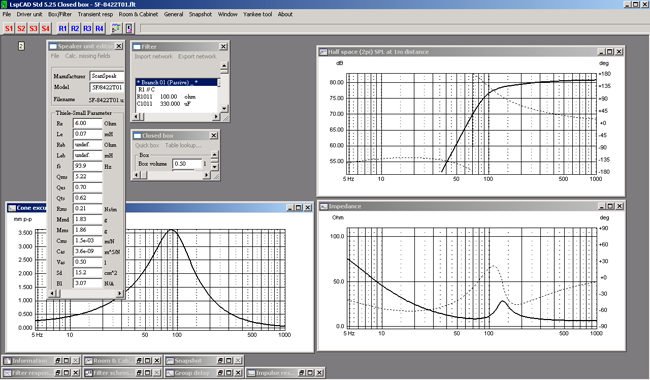ScanSpeak Micro, 5F/8422-T01
Copyright 2013 © Troels Gravesen
GO TO: BASIC MEASUREMENTS CROSSOVER CABINETS DESKTOP MEASUREMENTS
This is the smallest full range driver I've ever
had in hand! When it arrived from ScanSpeak my first thought was what on
Earth I could use this speaker for? Taking a closer look we find a 2" full
range driver fitted with a 22 mm titanium voice coil former and full SD
(Symmetric drive or copper clad pole piece), a thoroughly vented magnet
system with machined magnet parts and foam surround keeping a one-piece
paper cone in alignment. I mean, these are features rarely found on any
drivers except from ScanSpeak and AudioTechnology. And it does 100-20000
Hz with a fairly good linearity up to 7.5 kHz, most of the treble range
that matters. Well, given the 80 dB sensitivity we would have trouble
finding a bass driver for a 2-way system, but this is not what it is
meant for. 80 dB/2.8 volts may not seem like a whole lot, but we have to
consider we're going to listen at e.g. ½ metre distance, thus equivalent
to 86 dB/1 meter, 92 dB/2 metres, etc. Listening very close range is
more into something like head-phones or car-stereo.
Download ScanSpeak spec
here.
There may be two reasons your should buy the 5F: Cute-effect and/or it
just must be really small and used for a small desptop stereo
system. The cone size is only twice that of
a dome tweeter and it can't move much air as-is, but give it 330 uF to
protect from deep bass - and ad a 5" subwoofer and you may be well off
for a micro-system for your working desk. Placed close to the walls
and/or corners and it does give you a fair idea of what's going on "down
there". Compared to your in-built laptop "speakers", it's night and day.
Putting my hand on the test cabinet while playing "And I Love Her" by
Pat Metheny, I realised I had to make two seriously heavy cabinets lined
with bitumen pads and everything. These babies rock and deliver for
the size an astonishing response in upper-bass/lower midrange.
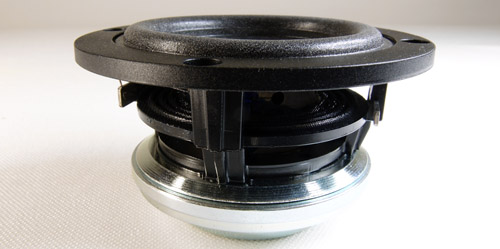
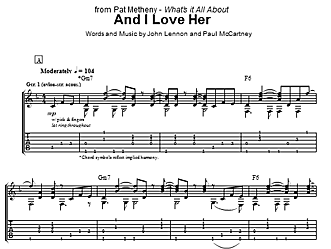
Click left image to view large
-it really is seriously cute and if you're gadget-happy,
it's a treat like a Swiss army knife!
Buy ScanSpeak 5F/8422T01 directly from ScanSpeak Online Store
First of all: SS must have done something to the driver after they made the data sheet, because the huge peak between 10 and 20 kHz is gone and this goes for both my drivers.
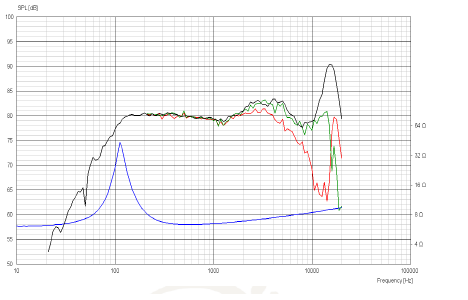
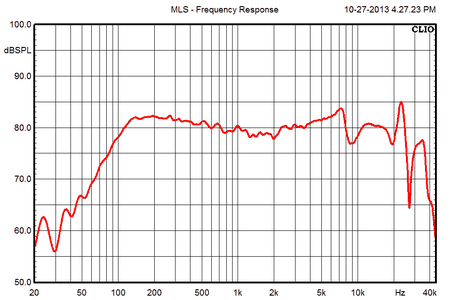
ScanSpeak measurement to the left. Someone punched the driver's "nose"
to make some +/- 3 dB between 10 and 20 kHz.
Pleased to see we agree on driver's sensitivity. 80 dB/2.8V it is.
Given the driver's sensitivity we may think this speaker needs a decent amplifier but we have to consider the cone size and its ability to move air. Certainly 15 square centimetres cannot move a lot of air and is certainly not meant to load a big room with music, rather sit on your desk next to your laptop playing your digital files via a DAC/AMP plugged into your laptop USB socket. In this case we do not need a big amp, which might soon blow the driver to pieces. I bought a small DAC/AMP from China to explore this option and it makes 2 x 10 watts and cost 100 USD. These things can be found on eBay and comes with either a coax input or a USB input. The USB is the easy solution and probably good enough for most. I bought the coax version allowing me to use my asynchronous Yulong U18 USB Digital Interface/24bit/192kHz, also from China. I use this for my CD-player's DAC.
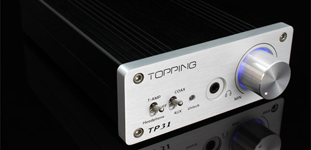
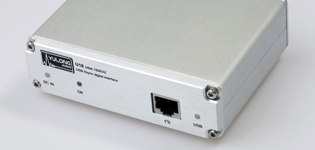
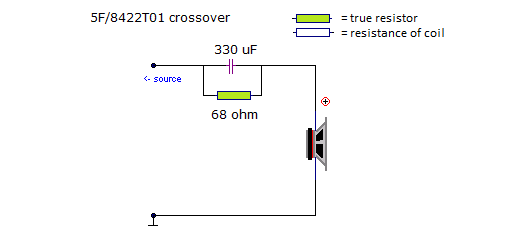
Simplest crossover on these pages! Use 330 uF
electrolytic a 47-100 Ohm 5-10 watt resistor.
The resistor will prevent your amp seeing a pure capacitive load in case
it doesn't like this.
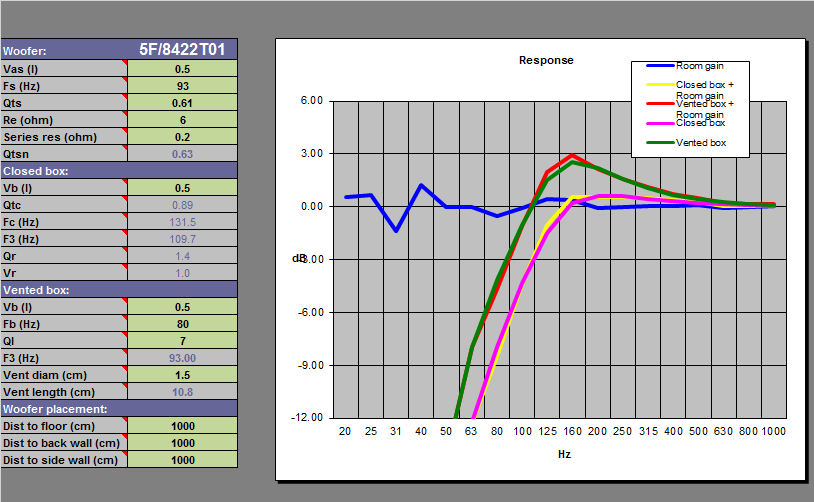
The simple box modelling looks like this for
a 0.5 litre closed and vented cabinet.
I think I'll stick to the closed box option and add a high-pass filter
to cut off lower frequences and hear what happens.
Above a more sophisticated LspCad simulation in a 0.5 litre closed box -
and a high-pass filter.
This doesn't look bad at all and placed on a desk near-wall/corner will
have some room gain augmenting lower frequences.
Cabinet(s)
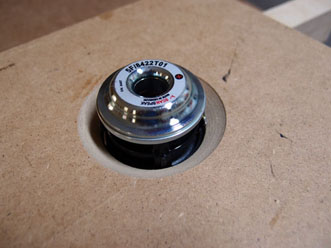
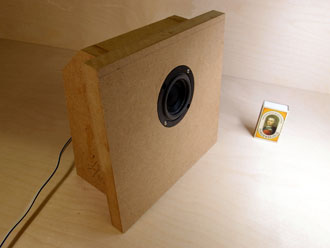
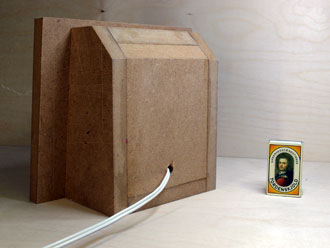
Routing for the 5F driver is easy and chamfering the driver holes is a MUST! This driver is so small we must ensure proper ventilation not to spoil all the good work done by SS to make this the best ventilated chassis/magnet on the market. Chamfer down to 2-3 mm from edge of driver hole. My test cabs were made to resemble my OBL speakers. Front panels are 200 x 180 mm (WxH). Behind the driver approx. 0.9 litre closed cabinets damped with 8 mm felt material. Based on modeling and measurements, I'll probably make the final cabinets 0.75 litre volume.
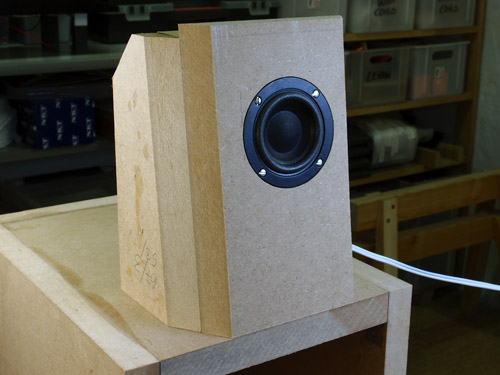
Test cabs chamfered. I like this better. Click image.
Front panels are 105 x 185 mm (WxH) (width to edge of chamfering).
Tilt is 7 deg. Overall cabinet width = 140 mm.
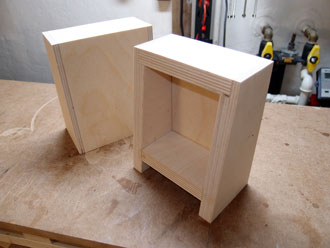
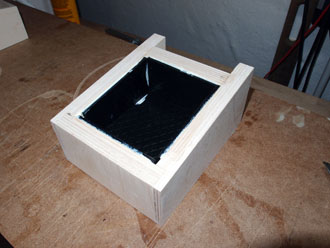
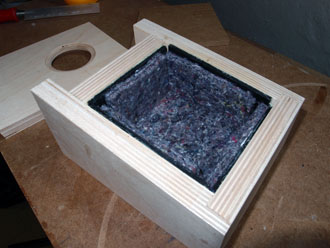
Making the final cabs. Middle: Bitumen pads added. Right: Felt
sheets added.
Desktop Measurements
BACK TO INDEX
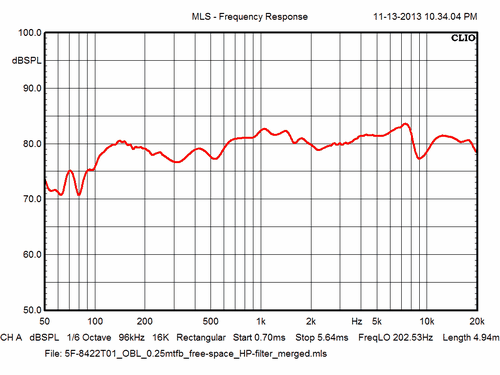
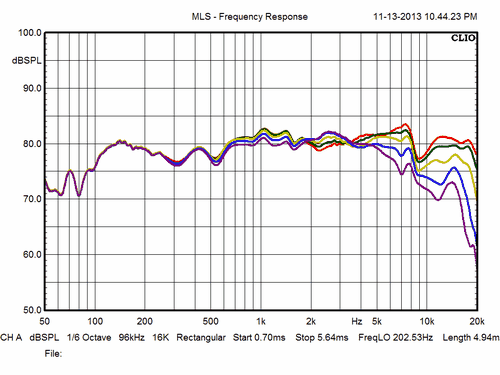
Above to the left SPL @ 0.25 m distance normalised for 1
m/2.8V. Response merged at 250 Hz with near-field response.
To the right horizontal dispersion at 0, 10, 20, 30 and 40 deg. Very
nice indeed from a full range driver!
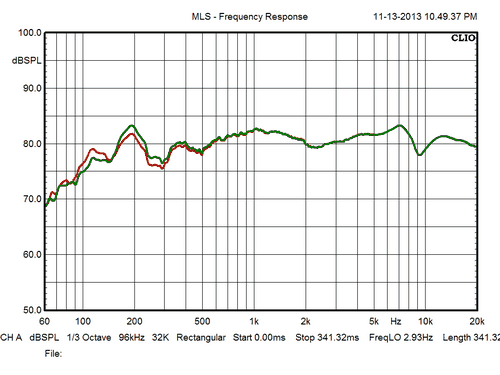
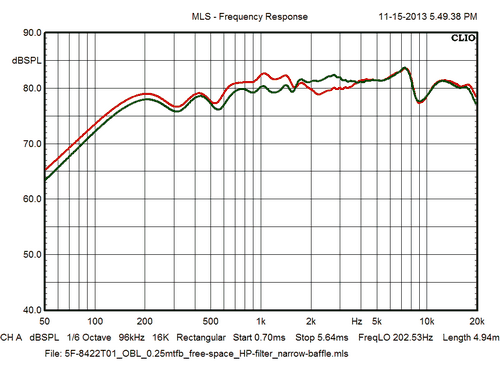
Left:
Response w/wo (green/red) high-pass filter connected.
The high-pass filter does very little, if anything, to the balance
above 100 Hz, but it surely protects the speaker from below 100 Hz
source material and allows significantly higher sound levels and the
small 10 watt DAC/AMP feels much better from cutting off low
frequences.
Right: Green is frequency response from chamfered cabinet (see
above) vs. "wide" baffle. Chamfering offers better linearity in
upper mid/lower treble. The loss in upper bass/lower mid is only
around 1 dB, but we rely on a lot of "desktop gain" in this area.
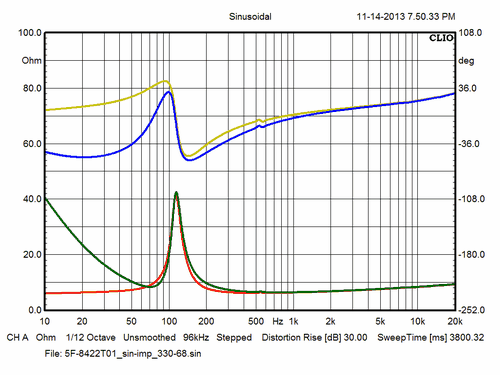
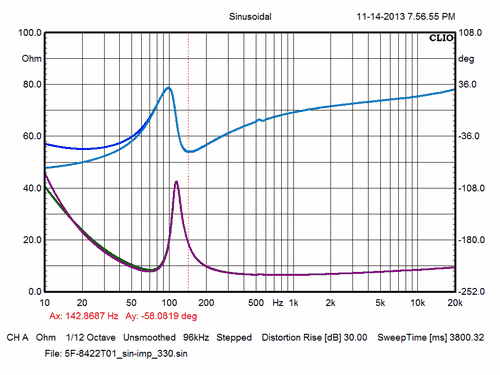
Left: Red/blue = impedance/phase without crossover. Green/light
green = impedance/phase with crossover (330 uF bypassed by 68 Ohm).
Right: Bypassing the 330 uF capacitor with 68 Ohms really doesn't do
much. I think I'll leave it out.
Desktop simulation
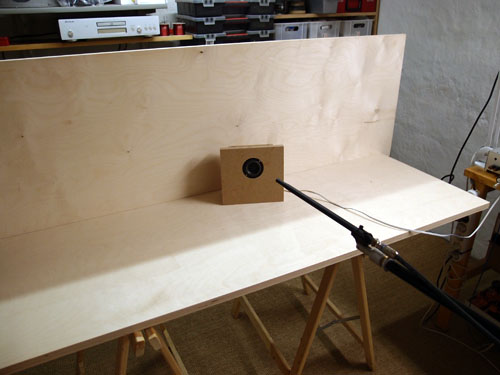
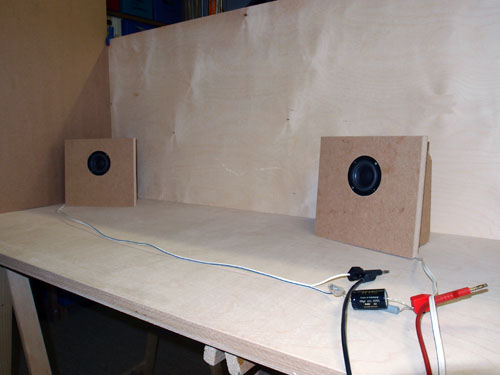
Pics above from desktop simulation, one speaker in corner. Quite
similar to my actual desktop.
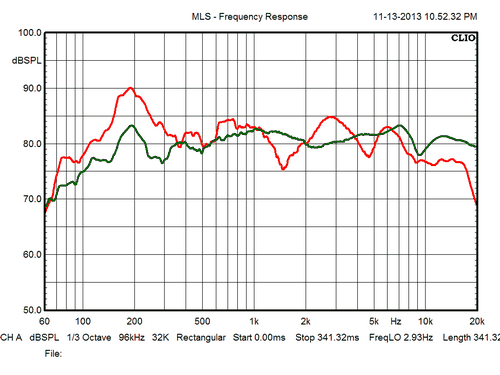
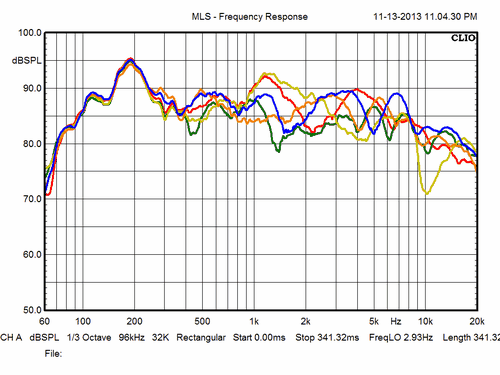
Left: Green = free-field measurement with a 340 ms window and 1/3
octave smoothing.
The only purpose of this is to show the impact of nearby boundaries
and the increased response in the upper bass/lower mid.
This makes the speakers sound more balanced and full-bodied.
Right: Both speakers driven from set-up shown on right photo above
and with the microphone in various positions at approx. 60-70 cm
distance.
All this may look pretty awful, but in fact sounds very good and
just a typical image of what small speakers may "look" like from
measurements under less than ideal conditions with reflections from
all over the place.
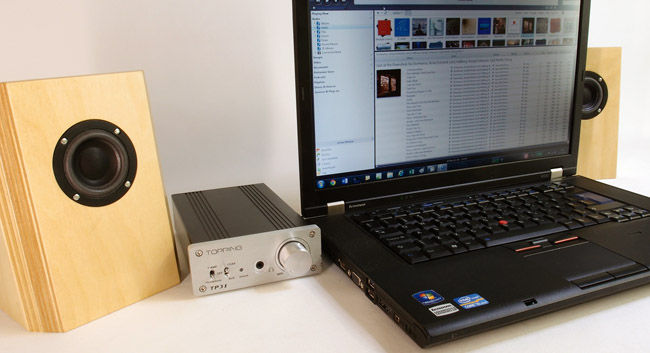
click image to view large
